 Technology peripherals
Technology peripherals
 AI
AI
 The world model also spreads! The trained agent turns out to be pretty good
The world model also spreads! The trained agent turns out to be pretty good
The world model also spreads! The trained agent turns out to be pretty good
World models provide a way to train reinforcement learning agents in a safe and sample-efficient manner. Recently, world models have mainly operated on discrete latent variable sequences to simulate environmental dynamics.
However, this method of compressing into compact discrete representations may ignore visual details that are important for reinforcement learning. On the other hand, diffusion models have become the dominant method for image generation, posing challenges to discrete latent models.
To promote this paradigm shift, researchers from the University of Geneva, the University of Edinburgh, and Microsoft Research jointly proposed a reinforcement learning agent trained in a diffuse world model—DIAMOND (DIffusion As a Model Of eNvironment Dreams).
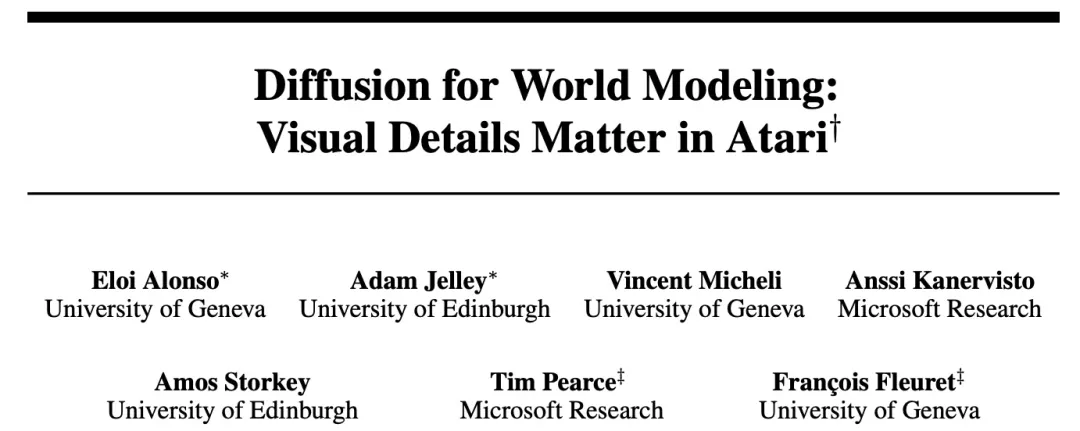
- ##Paper address: https://arxiv .org/abs/2405.12399
- Project address: https://github.com/eloialonso/diamond
- Paper title: Diffusion for World Modeling: Visual Details Matter in Atari
In the Atari 100k benchmark, DIAMOND+ achieved an average Human Normalized Score (HNS) of 1.46. This means that an agent trained in the world model can be fully trained at the SOTA level of an agent trained in the world model. This study provides a stability analysis to illustrate that DIAMOND design choices are necessary to ensure the long-term efficient stability of the diffusive world model.
In addition to the benefit of operating in image space, it enables the diffuse world model to become a direct representation of the environment, thus providing a deeper understanding of the world model and agent behavior. In particular, the study found that performance improvements in certain games result from better modeling of key visual details.
Method Introduction
Next, this article introduces DIAMOND, a reinforcement learning agent trained in a diffusion world model. Specifically, we base this on the drift and diffusion coefficients f and g introduced in Section 2.2, which correspond to a specific choice of diffusion paradigm. Furthermore, this study also chose the EDM formulation based on Karras et al.
First define a disturbance kernel, , where  is a real-valued function related to the diffusion time, called the noise schedule. This corresponds to setting the drift and diffusion coefficients to
is a real-valued function related to the diffusion time, called the noise schedule. This corresponds to setting the drift and diffusion coefficients to  and
and  .
. 
Then use the network preprocessing introduced by Karras et al. (2022), and parameterize in formula (5) as noise observations and neural network predictions Weighted sum of values: 



includes all condition variables. 
Preprocessor selection. Choose preprocessors  and
and  to maintain unit variance of network inputs and outputs at any noise level
to maintain unit variance of network inputs and outputs at any noise level  .
.  is the empirical conversion of noise level,
is the empirical conversion of noise level,  is given by
is given by  and the standard deviation of the data distribution
and the standard deviation of the data distribution  , the formula is
, the formula is 
Combined with formula 5 and 6. Get the  training target:
training target:

##This study uses standard U-Net 2D to construct the vector field, and retain a buffer containing the past L observations and actions to condition the model. Next they concatenated these past observations channel-wise with the next noisy observation and fed the actions into the residual block of U-Net via an adaptive group normalization layer. As discussed in Section 2.3 and Appendix A, there are many possible sampling methods to generate the next observation from a trained diffusion model. While the code base released by the study supports multiple sampling schemes, the study found that Euler methods are effective without requiring additional NFE (number of function evaluations) and avoiding the unnecessary complexity of higher-order samplers or random sampling. Effective. 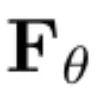
Experiment
To fully evaluate DIAMOND, the study used the well-established Atari 100k benchmark, which included 26 games, using For testing the broad capabilities of an agent. For each game, the agent was only allowed 100k actions in the environment, which is roughly equivalent to 2 hours of human game time, to learn to play the game before being evaluated. For reference, an Atari agent without constraints is typically trained for 50 million steps, which corresponds to a 500-fold increase in experience. The researchers trained DIAMOND from scratch on each game using 5 random seeds. Each run used approximately 12GB of VRAM and took approximately 2.9 days on a single Nvidia RTX 4090 (1.03 GPU years total).
Table 1 compares different scores for training agents on the world model:
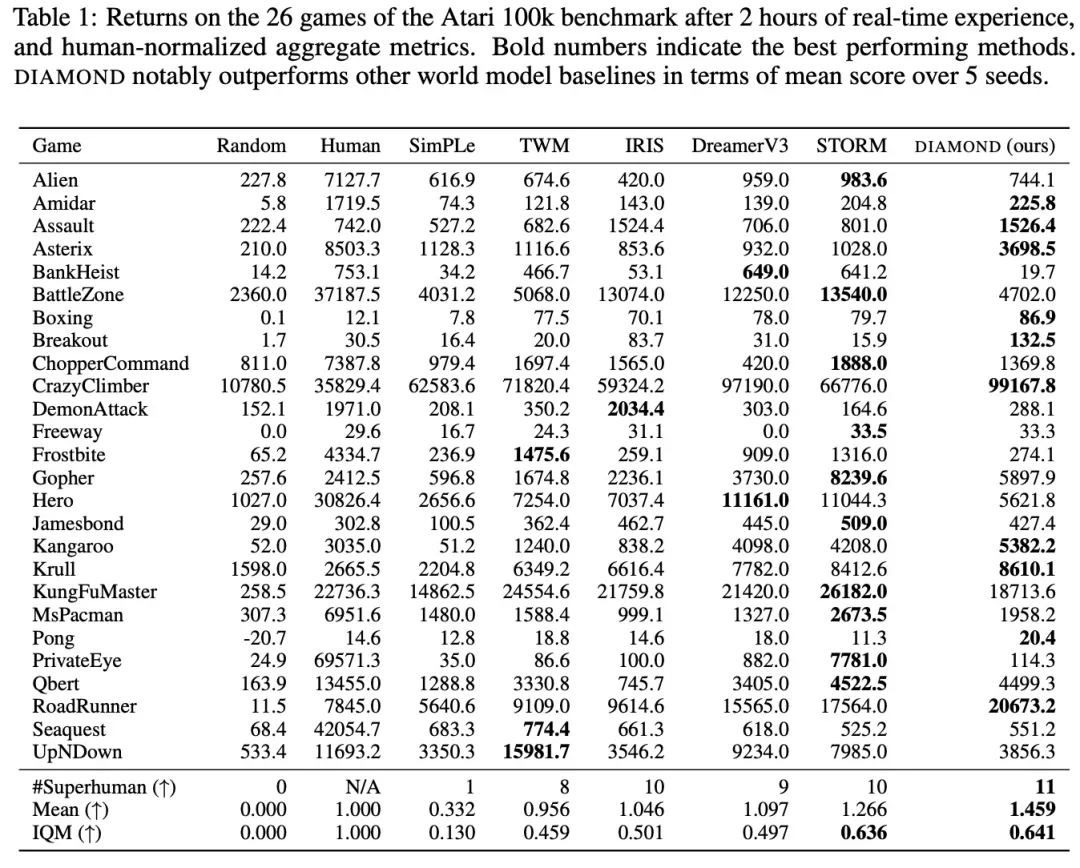
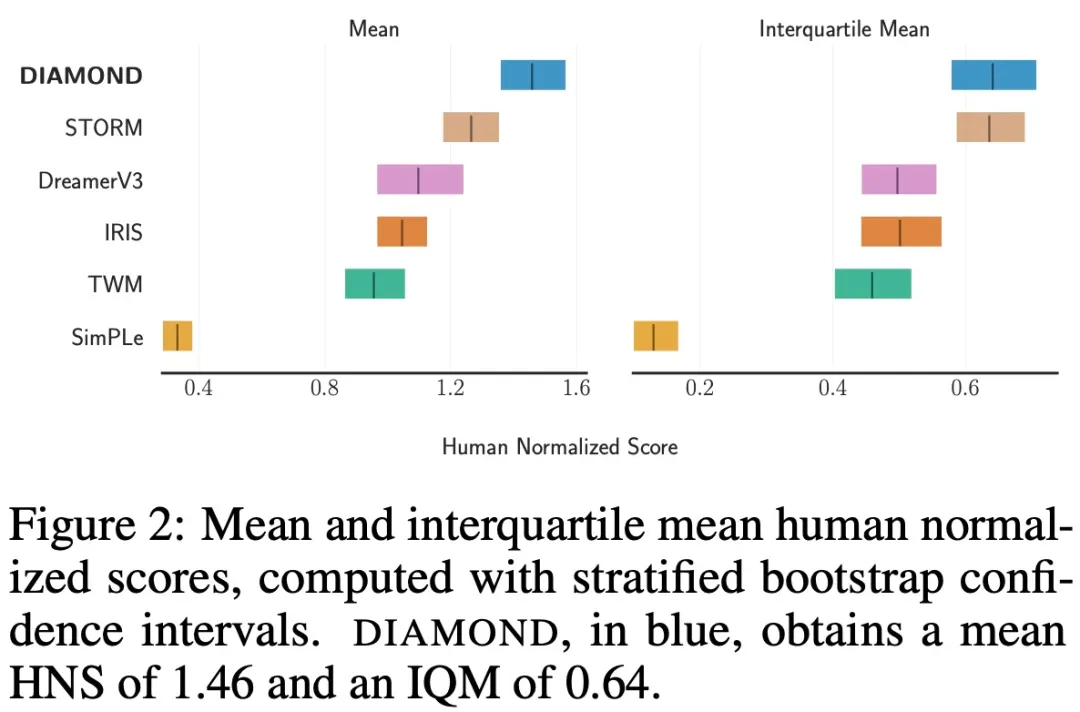
In order to study the stability of diffusion variables, this study analyzed the imagined trajectory generated by autoregression, as shown in Figure 3 below:
The study found that some situations require an iterative solver to drive the sampling process to a specific mode, such as the boxing game shown in Figure 4:

As shown in Figure 5, compared with the trajectories imagined by IRIS, the trajectories imagined by DIAMOND generally have higher visual quality and are more consistent with the real environment.
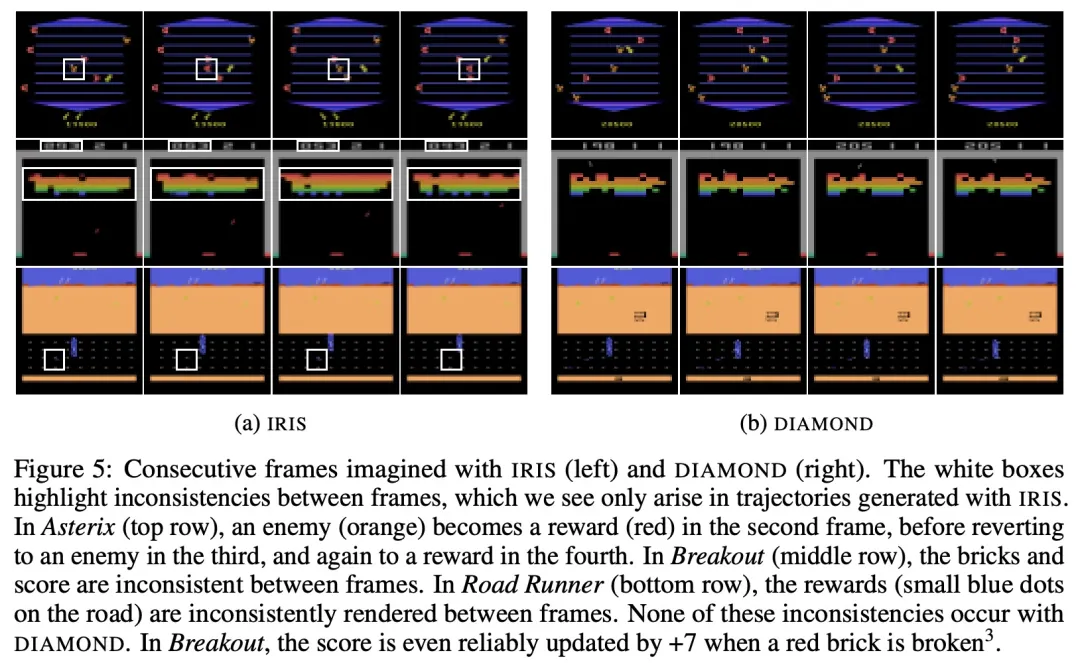
Interested readers can read the original text of the paper to learn more about the research content.
The above is the detailed content of The world model also spreads! The trained agent turns out to be pretty good. For more information, please follow other related articles on the PHP Chinese website!

Hot AI Tools

Undresser.AI Undress
AI-powered app for creating realistic nude photos

AI Clothes Remover
Online AI tool for removing clothes from photos.

Undress AI Tool
Undress images for free

Clothoff.io
AI clothes remover

Video Face Swap
Swap faces in any video effortlessly with our completely free AI face swap tool!

Hot Article

Hot Tools

Notepad++7.3.1
Easy-to-use and free code editor

SublimeText3 Chinese version
Chinese version, very easy to use

Zend Studio 13.0.1
Powerful PHP integrated development environment

Dreamweaver CS6
Visual web development tools

SublimeText3 Mac version
God-level code editing software (SublimeText3)

Hot Topics
 1664
1664
 14
14
 1423
1423
 52
52
 1317
1317
 25
25
 1268
1268
 29
29
 1243
1243
 24
24
 Open source! Beyond ZoeDepth! DepthFM: Fast and accurate monocular depth estimation!
Apr 03, 2024 pm 12:04 PM
Open source! Beyond ZoeDepth! DepthFM: Fast and accurate monocular depth estimation!
Apr 03, 2024 pm 12:04 PM
0.What does this article do? We propose DepthFM: a versatile and fast state-of-the-art generative monocular depth estimation model. In addition to traditional depth estimation tasks, DepthFM also demonstrates state-of-the-art capabilities in downstream tasks such as depth inpainting. DepthFM is efficient and can synthesize depth maps within a few inference steps. Let’s read about this work together ~ 1. Paper information title: DepthFM: FastMonocularDepthEstimationwithFlowMatching Author: MingGui, JohannesS.Fischer, UlrichPrestel, PingchuanMa, Dmytr
 Abandon the encoder-decoder architecture and use the diffusion model for edge detection, which is more effective. The National University of Defense Technology proposed DiffusionEdge
Feb 07, 2024 pm 10:12 PM
Abandon the encoder-decoder architecture and use the diffusion model for edge detection, which is more effective. The National University of Defense Technology proposed DiffusionEdge
Feb 07, 2024 pm 10:12 PM
Current deep edge detection networks usually adopt an encoder-decoder architecture, which contains up and down sampling modules to better extract multi-level features. However, this structure limits the network to output accurate and detailed edge detection results. In response to this problem, a paper on AAAI2024 provides a new solution. Thesis title: DiffusionEdge:DiffusionProbabilisticModelforCrispEdgeDetection Authors: Ye Yunfan (National University of Defense Technology), Xu Kai (National University of Defense Technology), Huang Yuxing (National University of Defense Technology), Yi Renjiao (National University of Defense Technology), Cai Zhiping (National University of Defense Technology) Paper link: https ://ar
 Tongyi Qianwen is open source again, Qwen1.5 brings six volume models, and its performance exceeds GPT3.5
Feb 07, 2024 pm 10:15 PM
Tongyi Qianwen is open source again, Qwen1.5 brings six volume models, and its performance exceeds GPT3.5
Feb 07, 2024 pm 10:15 PM
In time for the Spring Festival, version 1.5 of Tongyi Qianwen Model (Qwen) is online. This morning, the news of the new version attracted the attention of the AI community. The new version of the large model includes six model sizes: 0.5B, 1.8B, 4B, 7B, 14B and 72B. Among them, the performance of the strongest version surpasses GPT3.5 and Mistral-Medium. This version includes Base model and Chat model, and provides multi-language support. Alibaba’s Tongyi Qianwen team stated that the relevant technology has also been launched on the Tongyi Qianwen official website and Tongyi Qianwen App. In addition, today's release of Qwen 1.5 also has the following highlights: supports 32K context length; opens the checkpoint of the Base+Chat model;
 Large models can also be sliced, and Microsoft SliceGPT greatly increases the computational efficiency of LLAMA-2
Jan 31, 2024 am 11:39 AM
Large models can also be sliced, and Microsoft SliceGPT greatly increases the computational efficiency of LLAMA-2
Jan 31, 2024 am 11:39 AM
Large language models (LLMs) typically have billions of parameters and are trained on trillions of tokens. However, such models are very expensive to train and deploy. In order to reduce computational requirements, various model compression techniques are often used. These model compression techniques can generally be divided into four categories: distillation, tensor decomposition (including low-rank factorization), pruning, and quantization. Pruning methods have been around for some time, but many require recovery fine-tuning (RFT) after pruning to maintain performance, making the entire process costly and difficult to scale. Researchers from ETH Zurich and Microsoft have proposed a solution to this problem called SliceGPT. The core idea of this method is to reduce the embedding of the network by deleting rows and columns in the weight matrix.
 Hello, electric Atlas! Boston Dynamics robot comes back to life, 180-degree weird moves scare Musk
Apr 18, 2024 pm 07:58 PM
Hello, electric Atlas! Boston Dynamics robot comes back to life, 180-degree weird moves scare Musk
Apr 18, 2024 pm 07:58 PM
Boston Dynamics Atlas officially enters the era of electric robots! Yesterday, the hydraulic Atlas just "tearfully" withdrew from the stage of history. Today, Boston Dynamics announced that the electric Atlas is on the job. It seems that in the field of commercial humanoid robots, Boston Dynamics is determined to compete with Tesla. After the new video was released, it had already been viewed by more than one million people in just ten hours. The old people leave and new roles appear. This is a historical necessity. There is no doubt that this year is the explosive year of humanoid robots. Netizens commented: The advancement of robots has made this year's opening ceremony look like a human, and the degree of freedom is far greater than that of humans. But is this really not a horror movie? At the beginning of the video, Atlas is lying calmly on the ground, seemingly on his back. What follows is jaw-dropping
 LLaVA-1.6, which catches up with Gemini Pro and improves reasoning and OCR capabilities, is too powerful
Feb 01, 2024 pm 04:51 PM
LLaVA-1.6, which catches up with Gemini Pro and improves reasoning and OCR capabilities, is too powerful
Feb 01, 2024 pm 04:51 PM
In April last year, researchers from the University of Wisconsin-Madison, Microsoft Research, and Columbia University jointly released LLaVA (Large Language and Vision Assistant). Although LLaVA is only trained with a small multi-modal instruction data set, it shows very similar inference results to GPT-4 on some samples. Then in October, they launched LLaVA-1.5, which refreshed the SOTA in 11 benchmarks with simple modifications to the original LLaVA. The results of this upgrade are very exciting, bringing new breakthroughs to the field of multi-modal AI assistants. The research team announced the launch of LLaVA-1.6 version, targeting reasoning, OCR and
 Kuaishou version of Sora 'Ke Ling' is open for testing: generates over 120s video, understands physics better, and can accurately model complex movements
Jun 11, 2024 am 09:51 AM
Kuaishou version of Sora 'Ke Ling' is open for testing: generates over 120s video, understands physics better, and can accurately model complex movements
Jun 11, 2024 am 09:51 AM
What? Is Zootopia brought into reality by domestic AI? Exposed together with the video is a new large-scale domestic video generation model called "Keling". Sora uses a similar technical route and combines a number of self-developed technological innovations to produce videos that not only have large and reasonable movements, but also simulate the characteristics of the physical world and have strong conceptual combination capabilities and imagination. According to the data, Keling supports the generation of ultra-long videos of up to 2 minutes at 30fps, with resolutions up to 1080p, and supports multiple aspect ratios. Another important point is that Keling is not a demo or video result demonstration released by the laboratory, but a product-level application launched by Kuaishou, a leading player in the short video field. Moreover, the main focus is to be pragmatic, not to write blank checks, and to go online as soon as it is released. The large model of Ke Ling is already available in Kuaiying.
 The vitality of super intelligence awakens! But with the arrival of self-updating AI, mothers no longer have to worry about data bottlenecks
Apr 29, 2024 pm 06:55 PM
The vitality of super intelligence awakens! But with the arrival of self-updating AI, mothers no longer have to worry about data bottlenecks
Apr 29, 2024 pm 06:55 PM
I cry to death. The world is madly building big models. The data on the Internet is not enough. It is not enough at all. The training model looks like "The Hunger Games", and AI researchers around the world are worrying about how to feed these data voracious eaters. This problem is particularly prominent in multi-modal tasks. At a time when nothing could be done, a start-up team from the Department of Renmin University of China used its own new model to become the first in China to make "model-generated data feed itself" a reality. Moreover, it is a two-pronged approach on the understanding side and the generation side. Both sides can generate high-quality, multi-modal new data and provide data feedback to the model itself. What is a model? Awaker 1.0, a large multi-modal model that just appeared on the Zhongguancun Forum. Who is the team? Sophon engine. Founded by Gao Yizhao, a doctoral student at Renmin University’s Hillhouse School of Artificial Intelligence.



